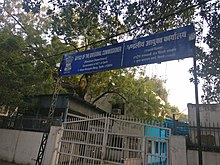| Commissioner of Divisional | |
|---|---|
 Incumbent IncumbentDivisional Commissioner | |
| Indian Administrative Service | |
| Type | Administrator of a division of a state in India |
| Abbreviation | DC or CD |
| Member of |
|
| Appointer | Respective Government of Indian State and Union Territories |
A Divisional Commissioner, also known as Commissioner of division, is an Indian Administrative Service officer who serves as the administrator of a division of a state in India. The post is referred to as regional commissioner in Karnataka and as revenue divisional commissioner in Odisha.
Office-bearers are generally either of the ranks of secretary to the state government, or principal secretary to state government.
The role of a divisional commissioner's office is to act as the administrative head of all the state government offices situated in the division. A divisional commissioner is given the direct responsibility of administering the land revenue collection, canal revenue collection and law & order maintenance of a division. The divisional commissioner also presides over Local government institutions in the division. Officers are transferred to and from the post by the state government. This post exists in many states of India. Divisional commissioners are responsible for general administration of the division and planned development of the districts under his control and also act as appeal adalat for revenue cases.
History of divisional commissioner
The division as an administrative level came into being in 1829 by the East India Company to facilitate the administration of far flung districts as a result of an increase in the scope of operations corresponding to the expansion of British territories. Each division was put under the charge of a divisional commissioner. The position was also known as Commissioner of Revenue and Circuit Division because he was the presiding officer of circuit court, it had appellate jurisdiction over sessions court. The post was created by then the Bengal government. The institution of divisional commissioner was created by Lord William Bentinck.
The appointment of commissioners in the subsequently acquired provinces of Punjab, Burma, Oudh and the Central Provinces followed in due course. The commissioner had intermediary role between district collector and board of revenue.
The Royal Commission for Decentralisation, 1907 recommended its retention. The issue, however, continued to crop up again and again, particularly at the time of constitutional reforms of 1919, 1935, and 1947. After independence, the state governments merely tinkered with traditional revenue set-up and the states of Maharashtra, Rajasthan, and Gujarat abolished the posts of divisional commissioners but later revived them except in Gujarat.
Role of divisional commissioner
The roles and powers of commissioners vary from state to state but there is a general precedent. The divisional commissioner performs a variety of roles in regional administration. Today, district magistrates are quite junior officers, needing the guidance and supervision of a seasoned administrator like the divisional commissioner. During the British period, a member of the Indian Civil Service was normally appointed a collector of the district in his twelfth year of service. Today a member of the IAS becomes a district collector after putting in five or six years of service. With his or her insufficient administrative experience, a district collector of today necessarily needs guidance. The divisional commissioners, therefore, are a necessary part of the governmental machinery.
Exception
The states and union territories in India that do not have divisions and thus do not have divisional commissioners are as follows:
- Kerala
- Goa
- Tamil Nadu
- Andhra Pradesh
- Telangana
- Gujarat
- Manipur
- Mizoram
- Sikkim
- Lakshadweep (Union Territory)
- Chandigarh (Union Territory)
- Dadra and Nagar Haveli and Daman and Diu (Union Territory)
In these areas, administrative divisions are not established, and hence the role of a divisional commissioner, who typically oversees revenue administration at the divisional level, does not exist. The district administration reports to the revenue department of the government.
References
- "Power & Functions of Regional Commissioner". Office of the Regional Commissioner, Belagum. Archived from the original on 17 June 2022. Retrieved 15 August 2017.
- ^ "Second Administrative Reforms Commission - Fifteenth Report - State and District Administration" (PDF). Second Administrative Reform Commission, Government of India. April 2009. p. 43. Archived from the original (PDF) on 1 June 2010. Retrieved 11 September 2017.
- ^ Maheshwari, S.R. (2000). Indian Administration (6th ed.). New Delhi: Orient Blackswan Private Ltd. pp. 563–572. ISBN 9788125019886.
- ^ Singh, G.P. (1993). Revenue administration in India: A case study of Bihar. Delhi: Mittal Publications. pp. 26–129. ISBN 978-8170993810.
- ^ Laxmikanth, M. (2014). Governance in India (2nd ed.). Noida: McGraw Hill Education. pp. 5.1 – 5.2. ISBN 978-9339204785.
- "THE RAJASTHAN DIVISIONAL COMMISSIONER (OFFICE ABOLITION) ACT, 1962 (Raj Act No. 8 of 1962)" (PDF). Department of Revenue, Government of Rajasthan. 1962. Retrieved 13 September 2017.
- "Collectorate". Department of Revenue, Government of Gujarat. Archived from the original on 14 June 2022. Retrieved 11 September 2017.
- "Role and Functions of Divisional Commissioner". Your Article Library. 6 January 2015. Retrieved 20 August 2017.
- http://103.1.174.97/newcms/attachments/article/233/Divisional%20Commissioner-%20Power%20and%20Function.pdf Archived 3 March 2016 at the Wayback Machine
- "Commissioner's Role". Office of the Divisional Commissioner, Jalandhar. Archived from the original on 16 August 2017. Retrieved 15 August 2017.
- "About us - Role of the Commissioner". Office of the Divisional Commissioner, Jabalpur. Archived from the original on 9 August 2017. Retrieved 15 August 2017.
- "Divisional administration of the states and union territories of India".
Bibliography
- Singh, G.P. (1993). Revenue administration in India: A case study of Bihar. Delhi: Mittal Publications. ISBN 978-8170993810.
- Maheshwari, S.R. (2000). Indian Administration (6th ed.). New Delhi: Orient Blackswan Private Ltd. ISBN 9788125019886.
- Laxmikanth, M. (2014). Governance in India (2nd ed.). Noida: McGraw Hill Education. ISBN 978-9339204785.